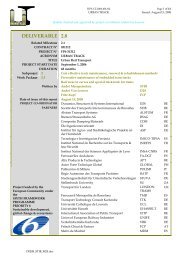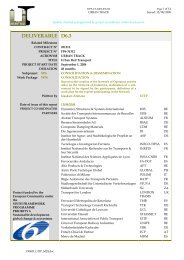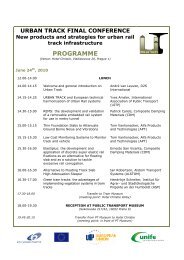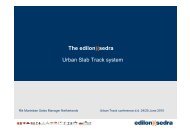Green tram tracks: the advantages of implementing ... - urban track
Green tram tracks: the advantages of implementing ... - urban track
Green tram tracks: the advantages of implementing ... - urban track
Create successful ePaper yourself
Turn your PDF publications into a flip-book with our unique Google optimized e-Paper software.
Final Conference URBAN TRACK<br />
<strong>Green</strong> Tram Tracks<br />
The Advantages <strong>of</strong> Implementing Vegetation Systems in Tram Tracks<br />
Institute for Agricultural and Urban Projects at <strong>the</strong> Humboldt-University, Berlin<br />
Dipl.-Ing. agr. Hendrikje Schreiter 24 June 2010, Prague
1 Sedum<br />
S. sexangulare<br />
S. spurium<br />
S. album S. floriferum<br />
2/20
1 Sedum<br />
• Sedum: genus <strong>of</strong> 500 species<br />
• Distribution: Nor<strong>the</strong>rn hemisphere,<br />
• 3 contrasting areas especially rich in Sedum:<br />
Mexico, Mediterranean Sea, Himalayan Mountains<br />
Natural Sedum distribution (STEPHENSON 1999)<br />
3/20
1 Sedum<br />
Sedum <strong>track</strong>, Berlin, Prenzlauer Allee, June 2009<br />
4/20
2 Demands on <strong>Green</strong> Tram Tracks<br />
• Adaption to <strong>track</strong> condition and local condition<br />
• Stray current (EN 50122-2)<br />
• Reduction <strong>of</strong> life cycle costs, which also means low maintenance<br />
• Optic all year round<br />
• Accessibility for snow clearing<br />
• Drainable but water retaining<br />
• Reduction <strong>of</strong> noise reflection<br />
• Drivable for emergency vehicles<br />
5/20
3 Drivable but <strong>Green</strong><br />
Track design for test site Brussels<br />
anti root layer<br />
Special absorber: Drain concrete Special absorber: Porous rubber Grass paver up to rubber jacket<br />
6/20
3 Drivable but <strong>Green</strong><br />
Fatigue test<br />
• simulated more than 34 years fatigue, at three wheel crossings a day<br />
Drain concrete test body at STUVA fatigue laboratory, after testing<br />
7/20
4 Noise Reduction<br />
Main noise source: contact <strong>of</strong> rail and wheel<br />
Reduction <strong>of</strong> reverberant surfaces<br />
Noise absorption at tor-level up to 2 - 4 dB (A) vs. ballasted <strong>track</strong><br />
Comparison <strong>of</strong> green <strong>track</strong> materials: noise absorption in impedance tube<br />
Substrate, Sedum, artificial grass, cavity elements, absorber, grass paver<br />
Rail-wheel contact<br />
Impedance tube(Brüel &<br />
Kjær, type 4206)<br />
Some test materials<br />
8/20
4 Noise Reduction<br />
Absorption<br />
between 500 - 1000 Hz:<br />
vegetation & artificial grass ><br />
substrate > drainasphalt and<br />
porous rubber mat > cavity<br />
elements<br />
Used materials with best<br />
absorption properties for <strong>track</strong><br />
design<br />
------------- XE I 1 ------------- XE I 2 ------------- XE I 4<br />
------------- XE II 5 ------------- XE II 3 ------------- XE II 6<br />
Comparison <strong>of</strong> two substrates: Xeroterr I (0/12) and Xeroterr II (0/8)<br />
α(Xeroterr I) > α(Xeroterr II)<br />
9/20
4 Noise Reduction<br />
� intensity [dB]<br />
Comparison <strong>of</strong> test bodies for sound absorption<br />
12<br />
10<br />
8<br />
6<br />
4<br />
2<br />
0<br />
-2<br />
-4<br />
-6<br />
-8<br />
-10<br />
-12<br />
Sound absorption measurements on testbodies: means <strong>of</strong> lower level<br />
(stimulation pink noise, measurement <strong>of</strong> sound intensity,<br />
difference levels to “unruffled concrete no. 1 and 2)<br />
CDM artificial grass high (No.G9 and G10)<br />
CDM cobbles (No.15 and 16)<br />
asphalt (No.3 and 4)<br />
cobbles concrete gap (No.9 and 10)<br />
Edilon cobbles structur (No.13 and 14)<br />
ballast<br />
split<br />
Sedum<br />
One-third octave frequency [Hz]<br />
Results <strong>of</strong> sound absorption measurements on test bodies: means <strong>of</strong> lower level (stimulation<br />
pink noise, measurement <strong>of</strong> sound intensity, difference levels to “unruffled concrete no. 1 and 2)<br />
Sound measurements, STUVA lab<br />
10/20
5 Life Cycle Cost Reduction<br />
Sedum =extensive naturation system<br />
Low maintenance needs (fertilzation)<br />
Compensating measures for<br />
surface sealing would cease to apply<br />
Cumulative LCC <strong>of</strong> <strong>the</strong> canditates over 50 years<br />
11/20
6 Optic, Habitat<br />
Tram <strong><strong>track</strong>s</strong> are part <strong>of</strong> <strong>the</strong> cityscape<br />
Aes<strong>the</strong>tic aspect<br />
<strong>Green</strong> space is brought into cities, natural and calm atmosphere.<br />
Some Sedum varieties are evergreen<br />
Habitat for innumerable insects and o<strong>the</strong>r invertebrates<br />
Chemnitz, Goe<strong>the</strong>straße before naturation Chemnitz, Goe<strong>the</strong>straße after naturation<br />
12/20
7 Water balance<br />
Problems in <strong>urban</strong> agglomerations<br />
www.inmoskau.de/blog/wpcontent/moscow-city-moskauth.jpg<br />
www.laits.utexas.edu/berlin/images/buildings/0<br />
5PotsdamerPlatz/c215_PotsdamerPlatz.jpg<br />
www.alleangebote.com/reisetipps/wpcontent/uploads/2009/05/new_york_city.jpg<br />
Reduction <strong>of</strong><br />
living quality<br />
Reduction <strong>of</strong><br />
air humidity<br />
Reduction <strong>of</strong><br />
evapotranspiration<br />
Sealed Surface<br />
Minimal Leaching<br />
Drop <strong>of</strong> water level<br />
Quick and<br />
elevated<br />
run-<strong>of</strong>f<br />
Sewerage load<br />
Ro<strong>of</strong> run-<strong>of</strong>f<br />
Danger <strong>of</strong> flooding,<br />
Quality reduction<br />
Negative impacts on <strong>urban</strong> water balance due to surface sealing<br />
(modified, from ILS 1993)<br />
13/20
7 Water balance<br />
Implementation <strong>of</strong> vegetation systems:<br />
greened area = unsealed or partly unsealed<br />
E<br />
T<br />
ΔW<br />
Water balance<br />
R<br />
P<br />
ΔW<br />
Precipitation<br />
E<br />
FK FK<br />
P � ET � R � �W<br />
R<br />
T<br />
Run-<strong>of</strong>f<br />
Transpiration<br />
E<br />
FK: Field capacity<br />
Elements <strong>of</strong> <strong>the</strong> water balance in a <strong>tram</strong> <strong>track</strong> naturation<br />
ΔW<br />
R<br />
T<br />
P= Precipitation;<br />
ET= Evaporation and<br />
Transpiration;<br />
R= Run-<strong>of</strong>f;<br />
ΔW=Water balance in<br />
<strong>the</strong> vegetations system<br />
[mm or l/m²];<br />
FK = field capacity<br />
Barcelona www.<strong>tram</strong>via.org<br />
14/20
7 Water balance<br />
Extensive vegetation systems: retain 50 % <strong>of</strong> precipitation.<br />
Intensive vegetation systems: retain 70 % up to 100 %<br />
Germany (IASP 2009):<br />
~ 4350 km single <strong>track</strong><br />
Potentially greenable: 1142 km<br />
Momentarily greened: 374 km<br />
326 km grass <strong><strong>track</strong>s</strong> => 81.5 ha: 453 460 m³ water storage<br />
48 km sedum <strong><strong>track</strong>s</strong> => 12 ha: 47.400 m³ water storage<br />
Altoge<strong>the</strong>r: 374 km are 500 860 m³ at 790 l/m²/a precipitation on average. Sedum <strong>track</strong>, Berlin, Germany<br />
15/20
8 Fine dust – Problems in <strong>urban</strong> agglomerations<br />
http://awearnessblog.com/NatalieBehring.jpg<br />
Nose<br />
> 10 µm<br />
Larynge<br />
4.7-5.8 µm<br />
Airway<br />
3.3-4.7 µm<br />
Increased risk <strong>of</strong> cancer<br />
Big bronchia<br />
3.3 -4.7 µm<br />
Medium bronchia<br />
1.1 -3.3 µm<br />
http://www.carylon.de/level9_cms/images_user/1142_Lunge_feinstaub_web.gif<br />
Alveole<br />
> 1.1 µm<br />
16/20
8 Fine dust – Contribution <strong>of</strong> green <strong><strong>track</strong>s</strong><br />
Path <strong>of</strong> dust through vegetation system<br />
REM: Fe- and Si- particles on Sedum spurium<br />
leaf surface, 9 µm<br />
Metals<br />
Sedum <strong>track</strong>: Fe 5300 mg/kg dm, Mn 110 mg/kg dm, Cu 40 mg/kg dm<br />
Reference: Fe 540 mg/kg dm, Mn 34 mg/kg dm, Cu 16.6 mg/kg dm<br />
Polycyclic aromatic hydrocarbons (PAH)<br />
Sedum <strong>track</strong>:1.870 mg/kg dm<br />
Reference: 0.989 mg/kg dm<br />
SEM/EDX: Presence <strong>of</strong> particles below 2.5 µm<br />
mainly Si- and Fe-particles<br />
PSS: 99 % <strong>of</strong> <strong>the</strong> particles < 8 µm (values under reserve)<br />
mean diameter 1,1 µm (values under reserve)<br />
17/20
8 Fine dust – Contribution <strong>of</strong> green <strong><strong>track</strong>s</strong><br />
During winter 100 % dust coverage <strong>of</strong> leaves<br />
Precipitation no big cleaning effect<br />
Accumulation <strong>of</strong> fine dust on leaf surface<br />
Wind tunnel<br />
Comparison: sedum vs. gravel, 0.23-20 µm<br />
Deposition: sedum > gravel<br />
1 m/s > 2 m/s<br />
highest deposition rate 2-10 µm<br />
Resuspension: sedum < gravel (2-10 µm)<br />
Sedum album - leaves from <strong>tram</strong> <strong>track</strong>, uncleaned<br />
Sedum album - leaves, cleaned<br />
18/20
9 Conclusions / Perspectives<br />
Anthropological impact on natural climate:<br />
Higher air pollution<br />
Accumulation <strong>of</strong> contaminants<br />
Changed water balance<br />
Heat island effect<br />
Loss <strong>of</strong> biodiversity<br />
Higher noise level<br />
http://www.kgs-gotha.de/jahr08/projektarbeit1/smog_mexico-city.jpg<br />
http://www.noise-busters.com/_borders/Original_NoiseBuster98.jpg<br />
19/20
9 Conclusions / Perspectives<br />
• Huge areas covered by <strong>tram</strong> <strong><strong>track</strong>s</strong><br />
• Optical aspect<br />
• Fine dust binding<br />
• Improves water balance & <strong>urban</strong> microclimate<br />
• Reduces noise<br />
• No compensatory measures<br />
• Biotop for flora and fauna<br />
Ecological potential with flower power<br />
S. sexangulare S. album S. spurium<br />
S. floriferum<br />
20/20








